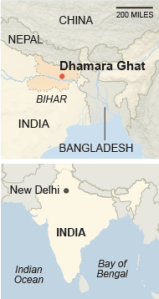 I’ve been away from my computer and traveling to some sites — I have much to tell, but for now, I must write about some serious global pilgrimage news from India. On August 19, an express train hit a crowd of Hindu pilgrims who were crossing the tracks in the eastern state of Bihar. The train came through as hundreds of pilgrims were disembarking from two passenger trains at Dhamara Ghat station. The Hindustan Times reports that the victims descending from the passenger trains were Hindu devotees rushing to the nearby Katyayani temple to mark the fourth and final Monday of the holy month of Sawan. Likewise, the NYT notes that the pilgrims were en route to offer holy water at the temple to Shiva; see also this BBC report. NBC news, however, notes that devotees were returning from offering morning prayers at Katyayani temple near Dhamara Ghat, a popular Hindu pilgrimage site. During the holy month of Sawan or Shravan, devotees of the Hindu deity Shiva head to holy sites across the country.
I’ve been away from my computer and traveling to some sites — I have much to tell, but for now, I must write about some serious global pilgrimage news from India. On August 19, an express train hit a crowd of Hindu pilgrims who were crossing the tracks in the eastern state of Bihar. The train came through as hundreds of pilgrims were disembarking from two passenger trains at Dhamara Ghat station. The Hindustan Times reports that the victims descending from the passenger trains were Hindu devotees rushing to the nearby Katyayani temple to mark the fourth and final Monday of the holy month of Sawan. Likewise, the NYT notes that the pilgrims were en route to offer holy water at the temple to Shiva; see also this BBC report. NBC news, however, notes that devotees were returning from offering morning prayers at Katyayani temple near Dhamara Ghat, a popular Hindu pilgrimage site. During the holy month of Sawan or Shravan, devotees of the Hindu deity Shiva head to holy sites across the country.
At least 37 people were killed. Passengers attacked the driver of the express train after the accident and set fire to the coaches. Continue reading


